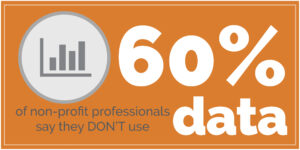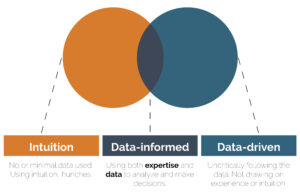Over the last decade, data has become a big deal and has become more present in our everyday lives and work environments. For the past 18 months, with COVID-19, we have all been using data to track incident rates, exposure rates, deaths, and vaccination rates. Data has equipped our leaders and the public with information to make decisions to keep us safe.
In addition to the national pandemic, we have seen significant trends that have catapulted the possibility and capability of using data to inform and help solve substantial everyday problems. Some of these trends include the development of new technology that has helped organizations collect, store, analyze, and share data more cost-effectively and collaboratively.
 With all of the advancements in technology and tools available, why are nonprofit organizations not using data?
With all of the advancements in technology and tools available, why are nonprofit organizations not using data?
Not all organizations can afford to have data analysts or event staff who are knowledgeable and proficient in data analysis (check out our blog here on data literacy). In addition to lacking staff capacity, there is also the issue of funding to purchase the technology software and hardware.
“The goal is to turn data into information, and information into insight.” ~ Carly Fiorina
What is a Data-Informed Organization?
 A data-informed organization blends staff’s “lived experience” and knowledge with objective data to make data-informed decisions. We often see organizations operating at one end of the pendulum, relying more on individual and collective experiences with minimal to limited regard for the data than organizations that only look at the data to inform decision-making.
A data-informed organization blends staff’s “lived experience” and knowledge with objective data to make data-informed decisions. We often see organizations operating at one end of the pendulum, relying more on individual and collective experiences with minimal to limited regard for the data than organizations that only look at the data to inform decision-making.
Being a data-informed organization requires a higher-level strategy that answers “how” and “why.”
Now that you have a common understanding of a data-informed organization, where would you rate your organization? What are the critical components of a data-informed organization, and how could you transition your organization?
What are 4 Components of a Data-Informed Organization?
- Clear Metrics—The organization has agreed upon key performance indicators (KPIs) that tie back to the mission and “theory of change,” and everyone understands the importance of these metrics and how their role/ team supports accomplishing them.
- Leadership Buy-In – The leadership is on board in understanding the importance of data, using data, and empowering and equipping their staff with data for decision-making
- Data Access—All employees need access to the data to glean insights and use it. The data must be Findable, Accessible, Interpretable, and Reusable (“FAIR”).
- Data Literacy—Staff has knowledge and understanding of data, terms, data tools, processes, schedules, and plans.
At Transform Consulting Group, we are passionate about helping organizations use their data to make a transformational impact and lasting change. It is what we do and is in our bones. This is the first blog in our series about what it means to be a data-informed organization. The following blog will discuss the roles in an organization that support a data-informed organization. We will also have a few blogs highlighting case study examples of organizations we are working with to help them transition to being a data-informed organization and how your organization can take these steps.
If you are ready to take that next step, contact us to schedule an individual consultation. You can also learn more about our data analysis solutions here.

